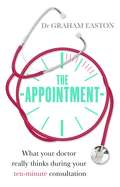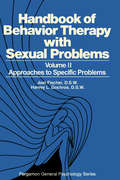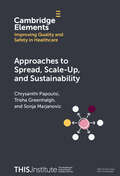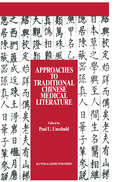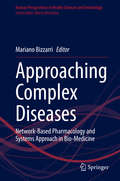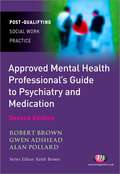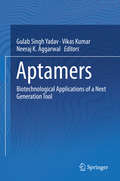- Table View
- List View
Applying the Therapeutic Function of Professional Supervision: Attending to the Emotional Impacts of Human Service Work
by Nicki WeldThis book brings a fresh approach and conversation to the practice of professional supervision for human services by specifically articulating its often performed, but unnamed and under-explored therapeutic function. The discussion of the therapeutic function is timely given the rising complexities in our world, and the increasing awareness of emotional impacts of human service work. These impacts include stress, distress, emotional labour, indirect trauma, and direct trauma. Posing a challenge and invitation to supervisors to comfortably inhabit the therapeutic function of supervision to increase emotional support to workers, it places safe practice and worker wellbeing at the heart of supervision to enable high quality service delivery for often the most vulnerable in society. While underpinned by theory, it is written to be practically applied and is developed from a ‘lived experience’ perspective, offering a unique glimpse into actual practice. By modelling one of the main aims of professional supervision, which is to facilitate and enable the integration of experience into learning and knowledge, it will be of interest to all practitioners across a broad range of human services, particularly both new and experienced supervisors.
The Appointment: What Your Doctor Really Thinks During Your Ten-Minute Consultation (Tom Thorne Novels #538)
by Dr Graham EastonDespite the modern trend towards empowering patients and giving them more choice, the nuts and bolts of medical practice largely remain a mystery - a closed box. In fact, the more health information is available on the internet, the more patients can feel swamped and confused. The Appointment offers an intimate and honest account of how a typical GP tries to make sense of a patient's health problems and manage them within the constraints of their health system and the short ten minute appointment. We have always been fascinated by our own health but in recent years, especially for older people, seeing the GP has become a regular activity. In the past decade the average number of times a patient visits his or her GP has almost doubled. Despite this increasing demand, getting to see a GP is not always easy so those intimate ten minutes with the doctor are extremely precious, and there's more than ever to cram in. Taking the reader through a typical morning surgery, The Appointment shines a light onto what is really going on in those central ten minutes and lets the reader, for the first time, get inside the mind of the person sitting in front of them - the professional they rely on to look after their health. Experienced GP Dr Graham Easton shows how GPs really think, lays bare their professional strengths and weaknesses, and exposes what really influences their decisions about their patients' health.
Appointment Planning in Outpatient Clinics and Diagnostic Facilities (SpringerBriefs in Health Care Management and Economics)
by Maartje E. ZonderlandAppointment Planning in Outpatient Clinics and Diagnostic Facilities provides a concise overview of the medical and mathematical aspects of appointment planning in healthcare. This SpringerBrief specifically focuses on outpatient clinics and diagnostic facilities. It begins by introducing the topic from a medical perspective, discussing the kinds of clinics and facilities that are out there, while exploring the appointment systems they use and the problems they face. Next, the mathematical aspects of appointment planning are examined, including Markov decision modelling, queueing theory, etc. Subsequently the book addresses implementation issues that may arise, whether they be technical, medical or cultural. Finally Appointment Planning in Outpatient Clinics and Diagnostic Facilities provides an outlook on the appointment systems of the future and what they will require as a consequence of current and future developments in the medical sector.
The Appraiser's Handbook: v. 5, Substance Abuse, Palliative Care, Musculoskeletal Conditions, Prescribing Practice
by Nick Lyons Susanne R Caesar Abayomi McEwenThis book contains a foreword by Maurice Conlon, Associate Director, Appraisal and Revalidation Lead, NHS Clinical Governance Support Team. This is an invaluable, detailed guide offering practical resources for medical professionals in the challenging role of appraiser. It assists with confidence, professionalism and competency and contains a comprehensive, up-to-date summary of the 'state of play' for appraising doctors. It also includes sample forms, contracts for guidance and links to web resources. "The Appraiser's Handbook" provides vital information for all those involved in continuing professional development in primary and secondary care. Appraisal leads and managers in primary and secondary care trusts will find it of great interest, as will clinical tutors, GP tutors and deanery educational teams. "This book aims to support appraisers in developing their skills in order to ensure that the doctor whom they appraise, gains the maximum possible benefit from the time spent in, and preparing for, the appraisal. The appraiser will find appraisees who enthusiastically embrace appraisal and those who doubt its use and place in their professional development. Different approaches may be needed to support and understand different individuals." - Nick Lyons, Susanne Caesar and Abayomi McEwen. "This book, written by a trio steeped in appraisal, is a valuable resource for appraisers. It will help doctors learning to be appraisers, and experienced appraisers. It will also help those organising appraisal, to remind them of the aims of the process. Teachers of appraisal will be able to use it to supplement and support their curricula. I believe revalidation, when it arrives, will be the single biggest step towards improvement taken by the profession, since the introduction of the medical register. I also believe this depends upon the inclusion of appraisal within the revalidation package. Putting high-quality, developmental appraisal 'in the water' for the medical profession will bring about a whole-profession shift in terms of lifelong professional development. This book will support that aim." - Maurice Conlon, in the Foreword.
The Appraiser's Handbook: v. 5, Substance Abuse, Palliative Care, Musculoskeletal Conditions, Prescribing Practice
by Nick Lyons Susanne R Caesar Abayomi McEwenThis book contains a foreword by Maurice Conlon, Associate Director, Appraisal and Revalidation Lead, NHS Clinical Governance Support Team. This is an invaluable, detailed guide offering practical resources for medical professionals in the challenging role of appraiser. It assists with confidence, professionalism and competency and contains a comprehensive, up-to-date summary of the 'state of play' for appraising doctors. It also includes sample forms, contracts for guidance and links to web resources. "The Appraiser's Handbook" provides vital information for all those involved in continuing professional development in primary and secondary care. Appraisal leads and managers in primary and secondary care trusts will find it of great interest, as will clinical tutors, GP tutors and deanery educational teams. "This book aims to support appraisers in developing their skills in order to ensure that the doctor whom they appraise, gains the maximum possible benefit from the time spent in, and preparing for, the appraisal. The appraiser will find appraisees who enthusiastically embrace appraisal and those who doubt its use and place in their professional development. Different approaches may be needed to support and understand different individuals." - Nick Lyons, Susanne Caesar and Abayomi McEwen. "This book, written by a trio steeped in appraisal, is a valuable resource for appraisers. It will help doctors learning to be appraisers, and experienced appraisers. It will also help those organising appraisal, to remind them of the aims of the process. Teachers of appraisal will be able to use it to supplement and support their curricula. I believe revalidation, when it arrives, will be the single biggest step towards improvement taken by the profession, since the introduction of the medical register. I also believe this depends upon the inclusion of appraisal within the revalidation package. Putting high-quality, developmental appraisal 'in the water' for the medical profession will bring about a whole-profession shift in terms of lifelong professional development. This book will support that aim." - Maurice Conlon, in the Foreword.
Approach to Internal Medicine: A Resource Book for Clinical Practice
by David HuiFeedback from users suggest this resource book is more comprehensive and more practical than many others in the market. One of its strengths is that it was written by trainees in internal medicine who understand the need for rapid access to accurate and concise clinical information, with a practical approach to clinical problem solving.
Approach to Internal Medicine: A Resource Book for Clinical Practice
by David Hui Alexander A. Leung Christopher MaThe fully updated fifth edition of this highly successful textbook provides an integrated symptom- and issue-based approach to internal medicine with easily accessible, high-yield clinical information. For each topic, carefully organized sections on different diagnoses, investigations, and treatments are designed to facilitate patient care and examination preparation. Numerous clinical pearls and comparison tables are provided to help enhance learning, and international units (US and metric) are used to facilitate application in everyday clinical practice. In addition to the central tenets of internal medicine, the book covers many highly important, rarely discussed topics in medicine, including: palliative care, obstetrical medicine, transfusion reactions, needle stick injuries, interpretation of gram stain, depression and code status discussion. This fifth edition additionally includes new coverage of the coronavirus-19 and cancer survivorship while being fully updated throughout. Authors present this information in a streamlined fashion, preserving the book’s pocket-sized, quick reference format. Approach to Internal Medicine continues to serve as an essential reference primarily for medical students, residents, and fellows -- with practicing physicians, nurses, and advanced practice providers also finding the text of value as a point of care reference.
Approach to Internal Medicine: A Resource Book for Clinical Practice
by David Hui Alexander A. Leung Raj PadwalThis fully updated 4th Edition of provides an integrated symptom- and issue-based approach with easy access to high yield clinical information. For each topic, carefully organized sections on different diagnoses, investigations, and treatments are designed to facilitate patient care and examination preparation. Numerous clinical pearls and comparison tables are provided to help enhance learning, and international units (US and metric) are used to facilitate application in everyday clinical practice.The book covers many highly important, rarely discussed topics in medicine (e.g., smoking cessation, obesity, transfusion reactions, needle stick injuries, code status discussion, interpretation of gram stain, palliative care), and new chapters on end-of-life care and depression have been added. The fourth edition includes many reader-friendly improvements such as better formatting, intuitive ordering of chapters, and incorporation of the most recent guidelines for each topic. Approach to Internal Medicine continues to serve as an essential reference for every medical student, resident, fellow, practicing physician, nurse, and physician assistant.
Approach to Lower Limb Oedema
by Satyendra K. TiwaryThe book covers all aspects of lower limb oedema including aetiology, pathophysiology, clinical approach, investigations, differential diagnosis and management. It presents all the medical and surgical aspects of lower limb oedema in a well-illustrated manner for better understanding. It covers the lower limb oedema of different origins separately to highlight the different spectrums in their presentation and management. Separate chapters include special conditions like pregnancy, trauma and vascular malformations. The book augments the learning and knowledge for lower limb oedema management by illustrating all aspects of it. It suggests proceeding with every possible aetiology with a better understanding of pathophysiology and adequate designated investigations. It also includes clinical guidelines that help to solve the diagnostic dilemma in lower limb oedema management with infused points to reach a consensus in each and every possible cause. The book includes recent scientific literature and accepted guidelines adopted from the publications during the last ten years to provide latest knowledge in the field. The approaches discussed in the book with specific importance to clinical workup and meticulous investigation protocols will help the surgeons, physicians, primary care workers as well as surgical resident trainees to reach the correct diagnosis and proper management.
Approaches to Breast Cancer Prevention (Developments in Oncology #62)
by Basil A. StollThis book is a logical companion volume to Women at High Risk to Breast Cancer (Kluwer, 1989) edited by me previously. It distinguishes two aspects of current ap proaches to clinical breast cancer prevention. The first is the need to advise individ ual women on how they might reduce their personal risk, while the second is the design of measures aimed at reducing the total incidence of breast cancer in the community. While the former is a problem faced daily by clinicians, the latter is a goal which will involve large scale, carefully planned interventional studies. Because knowledge of the risk factors for breast cancer is incomplete and clinical trial reports are scarce, there is as yet, no scientifically-based model for personal breast cancer prevention. Nevertheless, widespread publicity associated with breast screening programmes has created a large group of highly anxious women who have been informed that they are at higher than average risk to the disease. They are con cerned by the personal threat posed by a family history of the disease and by the al leged dangers of obesity, diet, alcohol, or the use of hormonal agents such as oral contraceptives or hormone replacement therapy.
Approaches to Chronic Kidney Disease: A Guide for Primary Care Providers and Non-Nephrologists
by Jerry McCauley Seyed Mehrdad Hamrahian Omar H. MaaroufChronic kidney disease (CKD) is a major global public health problem, affecting nearly one in seven adults in the United States alone. It is a disease that integrates chronic illness at several levels, and the progressive condition is associated with high rates of co-morbidity. This text provides a comprehensive, current state-of-the art review of this field, serving as a valuable resource for primary care providers and non-nephrology clinicians that treat patients with CKD. It is comprised of 24 chapters focused on specific aspects of the disease. The first 2 chapters provide a bit of background on the disease, describing the anatomy and physiology of the kidney as well as the definition and epidemiology of the disease. The following 3 chapters discuss the detection, prevention and progression of the disease. The next 6 chapters describe the relationship of the disease with other conditions and most common co-morbidities such as diabetes and hypertension. The chapters, that follow focus on the CKD associated complications and the CKD within special populations such as the elderly and minorities as well as dietary restrictions and drug dosing. The book concludes with discussion on preparation for renal replacement therapy and preemptive organ transplantation as an alternative to dialysis in the management of the advanced CKD. Written by experts in the field, Approach to Chronic Kidney Disease is a comprehensive guide for clinicians, especially primary care providers including residents and fellows in training, who take care of chronic kidney disease patients. It is also a useful tool for researchers dealing with this challenging field.
Approaches to Enhance Industrial Production of Fungal Cellulases (Fungal Biology)
by Manish Srivastava Neha Srivastava Pramod W. Ramteke Pradeep Kumar MishraCellulase is a key enzyme of industrial interest and plays a crucial role in the hydrolysis of cellulose, a prime component of plant cell walls. Cellulase covers a broad area in the global market of industrially important enzymes and it is considered as the third largest industrial enzyme globally. Additionally, cellulase contributes about 20% of the total enzyme market globally because of its massive demand in various industries such as in biofuel production, pulp, paper, textile, food, and beverages, as well as in detergent industries. Among these, the demand of cellulase may become frequently selected in the commercial production of biofuels in the future and thus will further increase demand of cellulase in the biofuel industry. Because biofuel production is still not realized in a cost-effective, practical implementation due to its high cost (the higher cost of biofuels is due to higher production costs of enzymes), there is a need to introduce these types of approaches, which will help to lower the cost of enzyme production for developing overall economic biofuel production.
Approaches to Measuring Human Behavior in the Social Environment
by William R. NugentMake the best use of measurement approaches that gauge social behaviorHere is a state-of-the-art examination of various approaches to measuring and assessing client functioning and specific aspects of clients&’ social environments. It examines numerous age groups and ethnic populations and makes use of cutting-edge methodologies in its examinations of measuring depression in children, measuring "the neighborhood" from a child&’s perspective, measuring and assessing family functioning, measuring spirituality, and measuring psychosocial problems in seriously mentally ill families. Helpful tables in each chapter make complex information easy to access and understand.Inside Approaches to Measuring Human Behavior in the Social Environment you&’ll find: a psychometric evaluation of the Structured Clinical Interview for DSM-IV Childhood Diagnoses (KID-SCID) (with 4 tables) a clinical/psychometric perspective on using self-rating scales for assessing severely mentally ill individuals (with a chapter appendix and 2 tables) vital information on assessing the influence of tradition upon Chinese elders in order to provide culturally sensitive services (with 4 tables) a report on the psychometric properties of the Rap Music Attitude and Perception (RAP) Scale, an instrument designed to measure attitudes toward and perceptions of rap music (with 6 tables) a report on the assessment of self-esteem in people with severe mental illness (with 2 figures and 4 tables) a qualitative study of fourth and fifth graders&’ views of the neighborhoods they live in (with 5 figures and 2 tables) an NIMH- and USDHHS-funded study examining the reliability and validity of the Preschool Symptom Self-Report (PRESS) which measures depression in maltreated young children (with 4 tables) a study of advances designed to improve the reliability/validity of the North Carolina Family Assessment Scale (NCFAS) as it relates to placement and the prediction of future placement within the context of Intensive Family Preservation Services (IFPS) (with 1 figure and 7 tables) conformatory factor analyses of the Secondary Traumatic Stress Scale (STSS) (with 3 figures and 4 tables) a report illustrating the development and empirical testing of the Spiritual Strategies Scale (SSS)-a measure of spiritual supports used by older adults in managing challenges in their lives (with 4 tables) an examination of the validity of college students&’ responses to the Scale for the Identification of Acquaintance Rape Attitudes (SIARA), a measure designed to assess attitudes believed to be supportive of sexual violence within dating relationships (with 3 figures and 5 tables)Approaches to Measuring Human Behavior in the Social Environment is vital reading for master&’s and PhD level social workers, psychologists, counselors, marriage and family therapists, psychiatrists, and researchers in these fields.
Approaches to Measuring Human Behavior in the Social Environment
by William R. NugentMake the best use of measurement approaches that gauge social behaviorHere is a state-of-the-art examination of various approaches to measuring and assessing client functioning and specific aspects of clients&’ social environments. It examines numerous age groups and ethnic populations and makes use of cutting-edge methodologies in its examinations of measuring depression in children, measuring "the neighborhood" from a child&’s perspective, measuring and assessing family functioning, measuring spirituality, and measuring psychosocial problems in seriously mentally ill families. Helpful tables in each chapter make complex information easy to access and understand.Inside Approaches to Measuring Human Behavior in the Social Environment you&’ll find: a psychometric evaluation of the Structured Clinical Interview for DSM-IV Childhood Diagnoses (KID-SCID) (with 4 tables) a clinical/psychometric perspective on using self-rating scales for assessing severely mentally ill individuals (with a chapter appendix and 2 tables) vital information on assessing the influence of tradition upon Chinese elders in order to provide culturally sensitive services (with 4 tables) a report on the psychometric properties of the Rap Music Attitude and Perception (RAP) Scale, an instrument designed to measure attitudes toward and perceptions of rap music (with 6 tables) a report on the assessment of self-esteem in people with severe mental illness (with 2 figures and 4 tables) a qualitative study of fourth and fifth graders&’ views of the neighborhoods they live in (with 5 figures and 2 tables) an NIMH- and USDHHS-funded study examining the reliability and validity of the Preschool Symptom Self-Report (PRESS) which measures depression in maltreated young children (with 4 tables) a study of advances designed to improve the reliability/validity of the North Carolina Family Assessment Scale (NCFAS) as it relates to placement and the prediction of future placement within the context of Intensive Family Preservation Services (IFPS) (with 1 figure and 7 tables) conformatory factor analyses of the Secondary Traumatic Stress Scale (STSS) (with 3 figures and 4 tables) a report illustrating the development and empirical testing of the Spiritual Strategies Scale (SSS)-a measure of spiritual supports used by older adults in managing challenges in their lives (with 4 tables) an examination of the validity of college students&’ responses to the Scale for the Identification of Acquaintance Rape Attitudes (SIARA), a measure designed to assess attitudes believed to be supportive of sexual violence within dating relationships (with 3 figures and 5 tables)Approaches to Measuring Human Behavior in the Social Environment is vital reading for master&’s and PhD level social workers, psychologists, counselors, marriage and family therapists, psychiatrists, and researchers in these fields.
Approaches to Specific Problems: Handbook of Behavior Therapy with Sexual Problems
by Joel Fischer Harvey L. GochrosHandbook of Behavior Therapy with Sexual Problems, Volume II: Approaches to Specific Problems compiles case studies illustrating the use of techniques as they are applied to specific sexual problems. This publication is divided into two parts. Part I discusses approaches to the problems often encountered by men and women in heterosexual intercourse. For men, the two major areas included are problems with achieving or maintaining erections during sexual activities and problems associated with ejaculation. The problem areas covered for women are problems in orgasmic functioning and problems of painful or difficult intercourse. Part 2 elaborates sexual problems associated with undesired sexual object choices. The homosexual, fetishistic, cross-dressing, exhibitionistic, pedophiliac, sadomasochistic, voyeuristic and miscellaneous behaviors are also covered. This publication is a good reference for behaviorally-oriented clinicians and practitioners who are attempting to alleviate the suffering associated with their clients' sexual problems.
Approaches to Spread, Scale-Up, and Sustainability (Elements of Improving Quality and Safety in Healthcare)
by null Chrysanthi Papoutsi null Trisha Greenhalgh null Sonja MarjanovicFew interventions that succeed in improving healthcare locally end up becoming spread and sustained more widely. This indicates that we need to think differently about spreading improvements in practice. Drawing on a focused review of academic and grey literature, the authors outline how spread, scale-up, and sustainability have been defined and operationalised, highlighting areas of ambiguity and contention. Following an overview of relevant frameworks and models, they focus on three specific approaches and unpack their theoretical assumptions and practical implications: the Dynamic Sustainability Framework, the 3S (structure, strategy, supports) infrastructure approach for scale-up, and the NASSS (non-adoption, abandonment, and challenges to scale-up, spread, and sustainability) framework. Key points are illustrated through empirical case narratives and the Element concludes with actionable learning for those engaged in improvement activities and for researchers. This title is also available as Open Access on Cambridge Core.
Approaches to Traditional Chinese Medical Literature: Proceedings of an International Symposium on Translation Methodologies and Terminologies
by Paul U. UnschuldProceedings of an International Symposium on Translation Methodologies and Terminologies
Approaching China's Pharmaceutical Market: A Fundamental Guide to Clinical Drug Development
by Ming Q. LuThis authoritative volume examines the major laws, regulations and guidelines related to pharmaceutical product development in China. With a focus on patent, clinical and registration strategies, the book helps Western companies introduce their clinical drugs to the Chinese market, determine a strategic path and bridge the gap for regulatory and legal differences between China and the Western world. For a better understanding of the drug registration process, it explores the differences between the China Food and Drug Administration (CFDA)—including its regulations and registration procedures—and those of the Western world. The volume discusses disparities between China's application requirements compared to Western standards to make it easier for companies to prepare their application packages. It also provides detailed commentary on CFDA guidelines in reference to clinical trial (IND) and market application (NDA) requirements. Overall, this book offers guidance for Western companies aspiring to expand into China’s pharmaceutical market in hopes that they may gain a fundamental understanding of its rules and complexities in order to ensure a smooth transition and prevent future issues.
Approaching Complex Diseases: Network-Based Pharmacology and Systems Approach in Bio-Medicine (Human Perspectives in Health Sciences and Technology #2)
by Mariano BizzarriThis volume – for pharmacologists, systems biologists, philosophers and historians of medicine – points to investigate new avenues in pharmacology research, by providing a full assessment of the premises underlying a radical shift in the pharmacology paradigm. The pharmaceutical industry is currently facing unparalleled challenges in developing innovative drugs. While drug-developing scientists in the 1990s mostly welcomed the transformation into a target-based approach, two decades of experience shows that this model is failing to boost both drug discovery and efficiency. Selected targets were often not druggable and with poor disease linkage, leading to either high toxicity or poor efficacy. Therefore, a profound rethinking of the current paradigm is needed. Advances in systems biology are revealing a phenotypic robustness and a network structure that strongly suggest that exquisitely selective compounds, compared with multitarget drugs, may exhibit lower than desired clinical efficacy. This appreciation of the role of polypharmacology has significant implications for tackling the two major sources of attrition in drug development, efficacy and toxicity. Integrating network biology and polypharmacology holds the promise of expanding the current opportunity space for druggable targets.
Appropriate Dose Selection - How to Optimize Clinical Drug Development (Ernst Schering Foundation Symposium Proceedings #59)
by J. Venitz W. SittnerOptimal dose individualization has become more important in improving clinical efficacy and safety. This is due in part to the variability in drug response. Therefore, the role of optimal dose finding in early clinical drug development so as to maximize successful clinical use is emphasized. This book reviews innovative methods, tools and examples of rational drug development strategies, particularly for novel oncological agents.
The Approved Mental Health Professional's Guide to Psychiatry and Medication
by Robert Brown Gwen Adshead Alan PollardThis book is essential reading for all Approved Mental Health Professionals (AMHPs) and those students and practitioners on mental health Post-Qualifying awards. It covers the core competencies of the AMHP and how the use of medication fits within the roles of the mental health professional. Fully updated to include aspects of the recently amended Mental Health Act 1983, this guide shows how the law is applied to compulsory administration of medication, the law relating to consent to treatment and the relevance to the European Convention on Human Rights.
Aptamers: Tools for Nanotherapy and Molecular Imaging
by Rakesh N. VeeduAptamers, often termed as ‘chemical antibodies,’ are an emerging class of synthetic ligands for efficient target-specific molecular recognition. The objective of this book is to highlight recent advances and potential of aptamers in various disease conditions. . This book focuses on the applications of aptamers in targeted nanotherapy, detection, and in molecular imaging in various disease conditions such as cancer, neurological diseases and infectious diseases.
Aptamers: Tools for Nanotherapy and Molecular Imaging
by Rakesh N. VeeduAptamers, often termed as ‘chemical antibodies,’ are an emerging class of synthetic ligands for efficient target-specific molecular recognition. The objective of this book is to highlight recent advances and potential of aptamers in various disease conditions. . This book focuses on the applications of aptamers in targeted nanotherapy, detection, and in molecular imaging in various disease conditions such as cancer, neurological diseases and infectious diseases.
Aptamers: Biotechnological Applications of a Next Generation Tool
by Gulab Singh Yadav Vikas Kumar Neeraj K. AggarwalThe book discusses the basics of aptamers and the advent of aptamer-based technology in recent times. The book covers the diverse applications of aptamers, such as in detection of animal and plant pathogens, disease diagnosis and therapeutics, environmental contamination detection etc. Besides these applications, the book also describes the use of these synthetic or modified DNA, as drug delivery vehicles.The different chapters describe how the binding capacity and specificity of aptamers can be exploited in various ways. The book also discusses how these attributes of aptamers can outdo the antibody technology in biomedical and diagnostic solutions. This crisp and concise book gives the readers an insight into the most recent biotechnological applications of aptamers.

